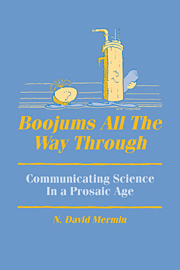Book contents
- Frontmatter
- Contents
- Preface
- I Reflections on the pursuit of physics
- II The quantum theory
- 10 Quantum mysteries for anyone
- 11 Can you help your team tonight by watching on TV?
- 12 Spooky actions at a distance: mysteries of the quantum theory
- 13 A bolt from the blue: the Einstein–Podolsky–Rosen paradox
- 14 The philosophical writings of Niels Bohr
- 15 The great quantum muddle
- 16 What's wrong with this pillow?
- III Relativity
- IV Mathematical musings
10 - Quantum mysteries for anyone
Published online by Cambridge University Press: 02 December 2009
- Frontmatter
- Contents
- Preface
- I Reflections on the pursuit of physics
- II The quantum theory
- 10 Quantum mysteries for anyone
- 11 Can you help your team tonight by watching on TV?
- 12 Spooky actions at a distance: mysteries of the quantum theory
- 13 A bolt from the blue: the Einstein–Podolsky–Rosen paradox
- 14 The philosophical writings of Niels Bohr
- 15 The great quantum muddle
- 16 What's wrong with this pillow?
- III Relativity
- IV Mathematical musings
Summary
We often discussed his notions on objective reality. I recall that during one walk Einstein suddenly stopped, turned to me and asked whether I really believed that the moon exists only when I look at it.
A. PaisAs O. Stern said recently, one should no more rack one's brain about the problem of whether something one cannot know anything about exists all the same, than about the ancient question of how many angels are able to sit on the point of a needle. But it seems to be that Einstein's questions are ultimately always of this kind.
W. PauliPauli and Einstein were both wrong. The questions with which Einstein attacked the quantum theory do have answers; but they are not the answers Einstein expected them to have. We now know that the moon is demonstrably not there when nobody looks.
The impact of this discovery on philosophy may have been blunted by the way in which it is conventionally stated, which leaves it fully accessible only to those with a working knowledge of quantum mechanics. I hope to remove that barrier by describing this remarkable aspect of nature in a way that presupposes no background whatever in the quantum theory or, for that matter, in classical physics either. I shall describe a piece of machinery that presents without any distortion one of the most strikingly peculiar features of the atomic world. No formal training in physics or mathematics is needed to grasp and ponder the extraordinary behavior of the device; it is only necessary to follow a simple counting argument on the level of a newspaper braintwister.
- Type
- Chapter
- Information
- Boojums All the Way throughCommunicating Science in a Prosaic Age, pp. 81 - 94Publisher: Cambridge University PressPrint publication year: 1990



